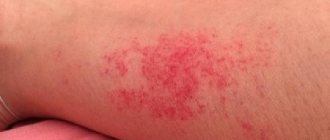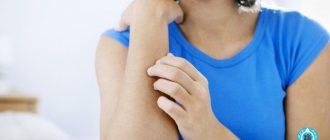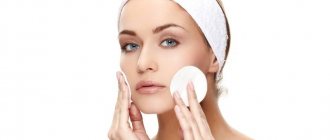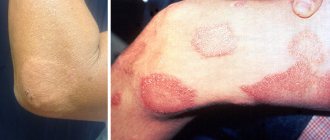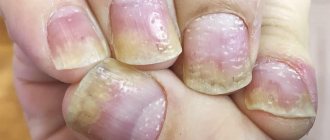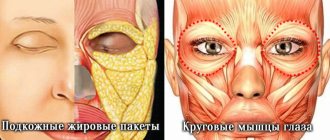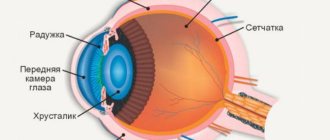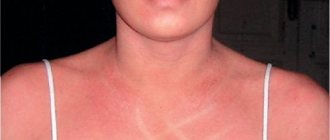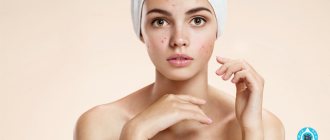Red spots on the skin appear in children and adults, regardless of gender. They indicate various diseases of a viral, bacterial or fungal nature. A rash may indicate an allergic reaction, psoriasis, or malignant processes.
Sometimes the rashes are accompanied by itching and pain, a rise in temperature and deterioration in well-being are possible. At the first symptoms, you should seek help from a doctor.
What are the spots?
Red defects differ in different parameters. They can be wet or dry, flaky or not flaky. Some diseases are characterized by itching, while others are painful. Sometimes the spots do not manifest themselves at all, causing only cosmetic discomfort. There are also those that appear and then disappear.
Patients should not make a diagnosis on their own; in the vast majority of cases, they do it incorrectly. The dermatologist will examine the papule, take a scraping if necessary and send it for the necessary tests. After this, patients are prescribed treatment.
Venereal disease (syphilis)
Sometimes red spots appear with syphilis. They resemble pale pink stars and appear during secondary syphilis. Patients feel unwell, the temperature rises, the lymph nodes become inflamed, and extensive growths appear on the genitals.
Allergic reactions
This is one of the most common causes of red spots. Skin allergies occur due to exposure to external irritants. They can be powders, soaps, shower gels and other personal hygiene products. Often the body becomes covered with a rash when the patient has eaten allergenic foods (chocolate, honey, citrus fruits, nuts, seafood).
Insect bites are accompanied by redness and swelling. The bites themselves are safe, but often the venom of insects (wasps, bees, bumblebees, even mosquitoes) causes allergic reactions.
Spots caused by individual intolerance are asymmetrical and localized in the neck, head and limbs. They peel and cause swelling of the skin. Papules are characterized by unbearable itching, which is especially intensified at night. Increases nervous excitability not only in children, but also in adults.
Diagnostic methods
To make an accurate diagnosis, the patient is given a referral for a general, biochemical blood test. An allergen test may be required if there is a suspicion of individual intolerance to a particular irritant.
A scraping is taken from the affected area. Additionally, an ultrasound of internal organs is performed.
The doctor gives a referral for examinations after a preliminary analysis. The doctor examines the patient's body. Additionally, the doctor conducts a survey of the patient to find out about additional signs.
Non-communicable diseases
Red spots occur due to diseases that are not contagious. Some of them are autoimmune in nature.
Photos and descriptions of diseases can be viewed on the Internet on thematic websites and forums. They are provided for informational purposes only; you should not make a diagnosis based only on the pictures.
Psoriasis
This is an autoimmune disease, the causes of which are still unknown. Most often it is hereditary. It is not cured, but the patient can enter a stage of long-term remission.
Red spots form on the body, which itch and flake. At first, they are easy to confuse with a rash. If you neglect treatment, they will cover up to 50% of the entire skin. Initially, plaques appear with smooth and thick edges; they can be easily removed. In their place, silvery scales form, and underneath them there is a red film (when it is removed, blood appears). Most often, plaques appear on the knees, elbows, and head.
Skin cancer
A malignant disease that needs to be treated. If you start therapy in the initial stages, the prognosis will be favorable.
A red spot appears on the skin, subsequently it grows, changes color, and often bleeds. Over time it turns into an ulcer.
Angioma
This is a red mole, but it can reach large sizes, over 10 centimeters. Often found on open areas of the skin (face or neck). Angiomas are harmless in most cases, but if they are regularly injured, they can degenerate. Red moles occur if the nature of the blood vessels is disrupted. They are removed surgically.
Possible reasons
It is impossible to independently determine why red dots appear. A rash is a symptom of many disorders. The epidermis is one of the first to react to all negative changes occurring in the body. Usually the rash disappears on its own after a few days, but sometimes medical attention is required.
The following reasons for the appearance are the most common:
- allergic reaction;
- injury to blood vessels;
- contagious diseases;
- non-infectious pathologies;
- avitaminosis.
Often the rash is the result of extreme stress. Such formations spread quickly and are very itchy. Sedatives are rarely required. Enough to rest more and protect yourself from stressful situations.
It cannot be ruled out that the dots present are, in fact, ordinary moles that do not pose a danger. Nevi always have clear outlines. The structure is uniform and the surface is smooth. The formations do not pose any danger to human health and life.
Diseases of an infectious nature
They can be caused by viruses or bacteria. The diseases are contagious; unvaccinated children often suffer from them, but there are often cases when adults are susceptible to pathologies. In such cases, the disease is severe.
In addition to the rash, patients suffer from other symptoms. Among them: fever or moderate increase in temperature, runny nose, sore throat, redness of the mucous membranes, weakness and lack of appetite. Often, red spots on the body itch and cause discomfort.
Chickenpox
This is an infectious disease caused by the herpes virus. It usually affects children, but if the child has not had it, he can become infected as an adult (in this situation the disease is severe).
Initially, red or pinkish spots appear on the body; after a few hours they fill with liquid, turning into small blisters. At the third stage, the papules burst, crusts form in their place, they last up to 5-6 days. Chickenpox may be accompanied by high fever, weakness, and headache.
Scarlet fever
Red spots on the body may indicate an infectious disease caused by streptococci. Scarlet fever is considered a childhood infection, but sometimes affects adults.
Patients develop a specific rash. Small red dots appear on the baby's neck and upper chest. They quickly move down the body, but never affect the nasolabial triangle. The rash peels off and plaques disappear by the end of the second week of illness.
Rubella
Viral infection is often acute. Small pink spots appear on the body, they do not peel or itch. The rash covers the face, buttocks, elbows and knees. Usually it lasts about 4 days, but sometimes for a whole week. In addition to spots, patients complain of fever, sore throat, runny nose, and enlarged lymph nodes.
Measles
This is a childhood disease, the most dangerous due to its complications. The first rash appears on the 4th day behind the patient’s ears. Then they cover the neck and chest. Over the next few days, a rash appears all over the body, including the fingers.
The spots are small and dense papules that rise above the skin. They are surrounded by spots, they grow quickly and merge with each other.
Borreliosis
The disease is transmitted by a tick bite. In an adult, a large red formation appears (in the place where the insect bit). It reaches up to 10 centimeters in diameter. After a week, the defect becomes lighter. It is characterized by severe itching and pain.
Streptoderma
This skin disease is caused by streptococcus bacteria. Red round spots appear on the body, which peel and itch. In addition, the affected part of the skin swells and hurts a little.
Patients note fever, weakness, enlarged lymph nodes, and nausea. People have headaches, muscles and joints. The size of the spots practically does not exceed two centimeters.
Key Aspects
To eliminate itchy spots on the skin, it is necessary, first of all, to establish the cause of their formation. To do this, the doctor carefully examines the history of the disease and may additionally prescribe a number of examinations.
The spots themselves are divided into:
- Primary.
- Secondary - formed over time when the primary elements of the rash change.
- Inflammatory. These spots are characterized by pronounced hyperemia combined with a cyanotic tint. When pressed, their color fades; as soon as the pressure stops, the color returns.
- Not inflammatory. Before their appearance, reactions of a vegetative nature result; this can be redness with a feeling of anger, as well as a violation of pigmentation of the skin.
- Roseolas, the size of which does not exceed 1 cm in diameter.
- Erythema - their size is more than 1 cm.
If it's a matter of lichen
A red spot in women and men can be lichen. This is a contagious disease usually caused by fungi. There are several types of lichen:
- Pink, also known as Zhiber's lichen - first a small maternal spot appears (no more than 4 cm in diameter), then a rash spreads over the body. Red and pink defects appear on the body, sometimes affecting the legs and arms.
- Shingles – red spots appear on the body and itch. The defects turn into bubbles filled with liquid, then it becomes cloudy, and the spots are retracted, forming a thick crust.
- Ringworm - this type appears on the scalp. A round-shaped focus of infection is formed, and the hair in this place falls out. Subsequently, until the lichen is cured, the hairs grow, but break off, the size does not exceed a couple of centimeters.
- Pityriasis or multi-colored - it forms on the body in the form of neoplasms. They come in not only pink and red, but also yellow and brown. Flaky spots with jagged edges are usually localized on the chest or back.
- Red or flat lichen is a speck in the form of small shiny nodules. There is a tendency to merge into large plaques. The spot is very itchy.
- Weeping appearance (another name for the disease is eczema) - a red, swollen defect with jagged edges appears on the body. It consists of many bubbles with liquid. They burst, and weeping eczema appears in place, then serous crusts.
Preventing stains
The likelihood of pathology occurring can be reduced through preventive measures.
Doctors recommend:
- Healthy food;
- lead a healthy lifestyle;
- keep the house and body clean;
- eliminate any illnesses in a timely manner;
- take medications only as prescribed by a doctor;
- do not contact people with transmittable diseases.
The main thing is to monitor your health and contact a medical facility for help in a timely manner.
Treatment
First, it is necessary to diagnose the pathology, then the dermatologist will prescribe therapeutic measures. They depend on what pathogens cause the spots.
- For viral pathologies, antiviral drugs are prescribed.
- If the defects are caused by allergies, then taking antihistamines is necessary.
- For bacterial infections, you need to take a course of antibiotics.
- If the spots are caused by fungi, then treatment will not be complete without the use of antifungal drugs.
Poor nutrition
Red spots can be caused by poor diet. Excessive addiction to smoked, fried, sweet, salty, spicy foods can provoke their appearance. To reduce symptoms, it is necessary to exclude “suspicious foods” from the diet.
Having excluded suspicious products, you need to observe the stains for several days. If the rashes have decreased, then the culprit was poor nutrition and the main treatment is minimal consumption of these products.
The basis of the fight against skin allergies: antihistamines and hormonal drugs
After all the necessary tests and studies, the doctor prescribes treatment. Treatment with medications always comes first - antihistamines and hormonal drugs are used for allergies.
The main tasks are the removal of all symptoms and further prevention. The mechanism of action of such drugs is different, since when an allergy occurs, a pathological protein develops in the body, which causes all the symptoms. The products are used in the form of tablets, ointments, injections and droppers, drops for the eyes, nose, and throat.
Antihistamine ointments act on the upper skin and relieve areas of redness, blisters, and reduce itching, that is, they relieve external signs of the process. Antihistamine tablets - stop the production of histamine and internally kill pathogenic bacteria. First-order antihistamine tablets include:
- Fenistal;
- Supratin;
- Pipolfen;
Supratin
In addition to the fact that they affect histamine, they have a number of side effects - drowsiness, decreased brain activity, increased blood pressure. Second-order tablets have fewer side effects, but they are not advisable for use by older people, as there is a large load on the organs of the cardiovascular system. Can be used:
- Erius;
- Claritin;
Erius
Tablets of the latest generation have entered medicine and are now being used by more and more people. They cause almost no side effects and have a positive effect on the course of the disease. These include:
- Trexil;
- Xizal;
- Cetrin;
Trexil neo
Injections can relieve pain and reduce symptoms in a matter of minutes. The use of hormones also relieves symptoms over a short period of time, the patient feels much better, and the itching quickly stops. They are prescribed for a short period of time - the first 2-3 days, then they move on to milder medications.
What to do if spots appear on your hands and then disappear?
If you notice disappearing spots on yourself, of course, first of all, there is no need to panic. Observe your condition for a while and consult a doctor. Tell him about your symptoms:
- Do they bother you?
- Do they cause itching?
- What medications are you currently taking?
- What is the shape of the spots and texture?
Based on your complaints, the doctor will prescribe tests and select the right treatment for you. Basically, such spots do not require special medical intervention.
Problem #4: Eczema
On the swollen area of the skin, tiny weeping bubbles appear, resembling dew drops. They quickly open with the formation of point erosions, which are later replaced by peeling and crusts.
Article on the topic
Eczema under control. How to deal with dry hands
Dermatologists distinguish between winter eczema, which only appears during the dry, cold season. In patients suffering from winter eczema, the disease most often affects the extremities - arms or legs. The skin becomes dry, its elasticity decreases, the fingertips resemble parchment paper - cracks form on them, which itch and bleed.
For any type of eczema, it is important to start treatment at the first signs of the disease, when the disease is easy to control. Delay may lead to the spread of the process, which will require the use of corticosteroid drugs.
